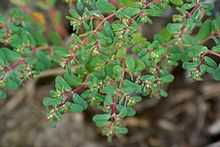Euphorbia serpyllifolia
| Euphorbia serpyllifolia | |
|---|---|
 | |
| Scientific classification | |
| Kingdom: | Plantae |
| (unranked): | Angiosperms |
| (unranked): | Eudicots |
| (unranked): | Rosids |
| Order: | Malpighiales |
| Family: | Euphorbiaceae |
| Genus: | Euphorbia |
| Species: | E. serpyllifolia |
| Binomial name | |
| Euphorbia serpyllifolia Pers. | |
| Subspecies | |
| |
| Synonyms | |
|
Chamaesyce serpyllifolia (Pers.) Small | |
Euphorbia serpyllifolia is a species of euphorb known by the common name thymeleaf sandmat, or thyme-leafed spurge. It is native to a large part of North America from Canada to Mexico, where it is a common member of the flora in many types of habitat. This is an annual herb growing as a prostrate mat or taking a somewhat erect form. The oblong leaves are up to about 1.5 centimeters long, sometimes hairy and finely toothed along the edges. The tiny inflorescence is a cyathium about a millimeter wide. It bears scalloped white petal-like appendages arranged around the actual flowers. At the center are several male flowers and one female flower, which develops into a lobed, oval fruit up to 2 millimeters wide. This plant had a number of traditional medicinal uses for many Native American groups.[1]
Sub-species
- One of the two subspecies of this plant, ssp. hirtula, is limited to California and Baja California.[2]
- The other sub-species, ssp. serpyllifolia, has far wider distribution throughout much of North America with a gap in interior eastern states of the United States.
Uses
The Zuni people use the serpyllifolia subspecies plant used a cathartic, an emetic, and to increase the flow of milk in a breastfeeding mother.[3] The leaves are also chewed for the pleasant taste and used to sweeten corn meal.[4]
References
- ↑ Ethnobotany
- ↑ Jepson Manual: ssp. hirtula
- ↑ Stevenson, Matilda Coxe 1915 Ethnobotany of the Zuni Indians. SI-BAE Annual Report #30 (p. 51)
- ↑ Stevenson, p.67